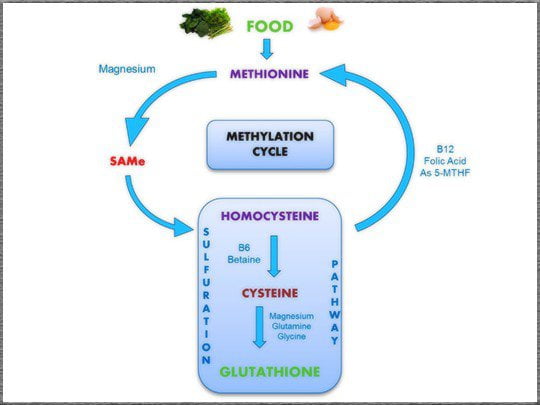Going further into the methylation cycle, a more scientific view of the cycle consists of several metabolites that play a key role in ensuring that an appropriate amount of methyl groups is constantly generated, as well as maintaining support for other biological functions.
Methionine
Starting at what is usually considered the “beginning” of the cycle, is methionine. Methionine is an essential amino acid and can be found in foods containing protein, and its ability to convert into Sulphur-containing compounds, some of which are also found in the methylation cycle. One of methionine’s important roles is the regeneration of new proteins upon the process of breaking down old proteins. This process can happen as some of the protein in

your muscles wear out after working out, and methionine steps in to produce new proteins.
S-Adenosyl Methionine (SAM) and S-Adenosyl Homocysteine (SAH)
Methionine forms what is called S-Adenosyl Methionine (SAM). SAM converts into S-Adenosyl Homocysteine and a methyl group. The methyl groups are added to substrates (This process is called methylation). Alongside SAM’s role in forming methyl groups, it also helps to produce and regulate hormones and maintain cell membranes. Because of the numerous functions methylation applies to, SAM supplements have various potential effects, such as relieving problems associated with heart disease, liver disease, treating psychiatric problems such as depression, anxiety, schizophrenia and more. Recently, there has been a rise in research of SAM’s effects as a pain reliever which could be helpful to people suffering from osteoarthritis, fibromyalgia and PMS.
Homocysteine
SAH breaks down into Homocysteine and Adenosine. Homocysteine is the next metabolite involved in the methylation cycle, and it stands in the crossroad leading to several pathways. Homocysteine can be converted back to methionine with the aid of vitamin B12 enzymes (hence the term methylation cycle), or it can be driven towards another pathway, the transsulfuration pathway which produces master antioxidant, glutathione. Homocysteine is also a biomarker for age-related neurodegenerative diseases and is associated with hypertension (high blood pressure) and cardiovascular disease.

